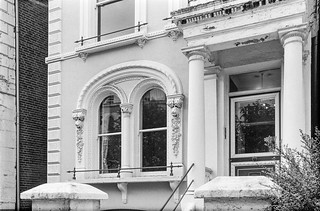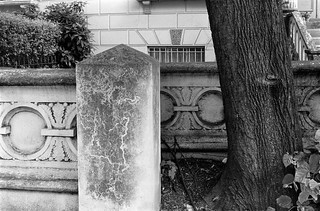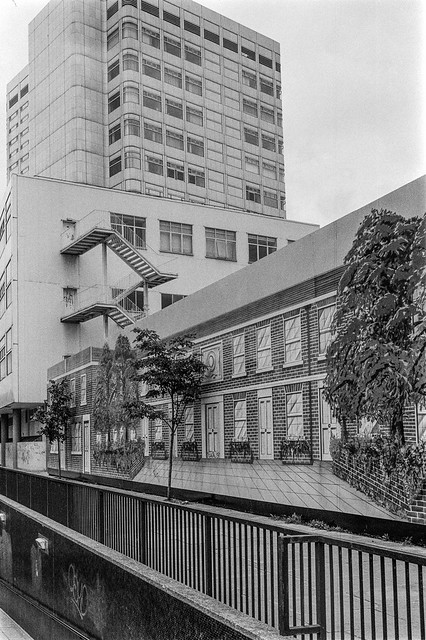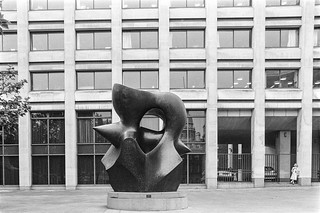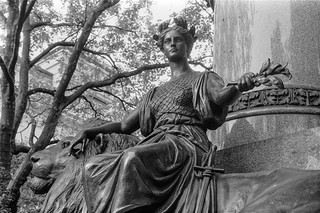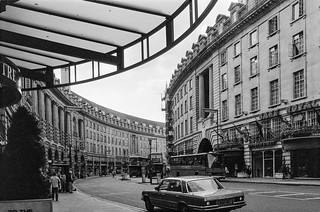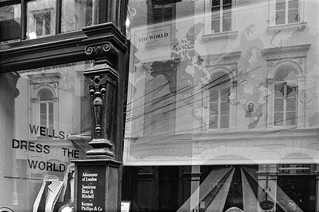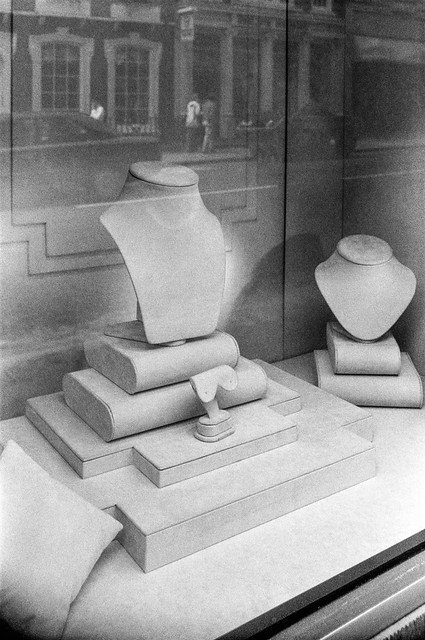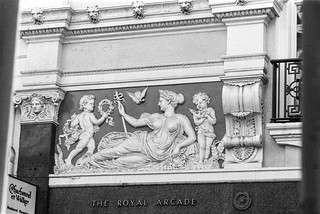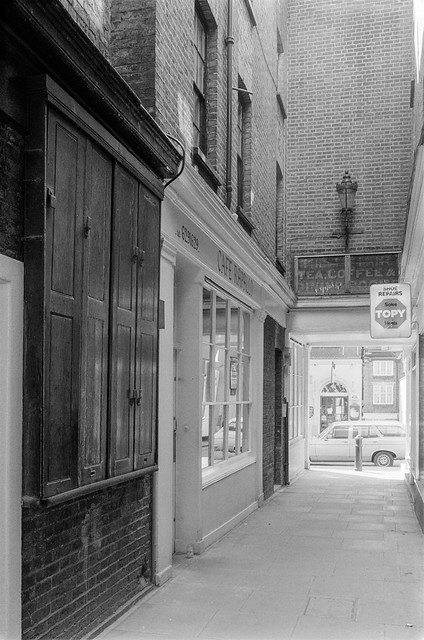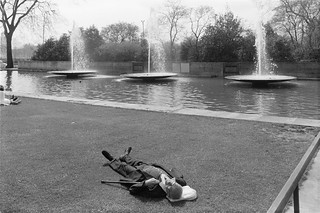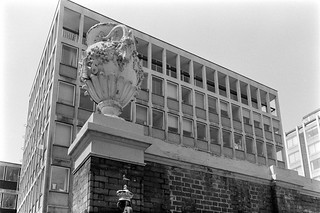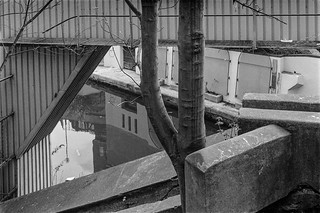Logically you might expect Wood’s House to be in Wood’s Mews, and it may well have been, but if so is no longer there. The frame before I took two pictures of this rather pleasant 1930s building was a view of the side in Wood’s Mews of a house in Park Lane, and the frame after is of another house further south on Park Lane on the corner of Culross St.
I suspect a building with only two stories became yielded a huge profit to developers in being built as an ugly but considerably taller block, but it would be nice to be proven wrong and to find this still tucked away in a corner.
I think this rather splendid marble (I think) steps are still there on Park Lane behind the high wall that now keeps them out of view of the hoi polloi who often crowd the area around the bus stops close to this corner with Green St.
Perhaps walls like that which now hides these steps and the view from the pavement of the houses behind are a result of the increase in inequality in our society and reflect an increasing unease among the elites. Though there have been few signs of the London mob in recent years. More likely the owners got fed up with finding people sitting on them waiting for buses.
Before the US joined in the Second World War at the end of 1941, 244 US citizens volunteered to join the RAF and served in the RAF, flying Spitfires and Hurricanes in three three Royal Air Force Eagle Squadrons, despite US laws which meant losing their citizenship for fighting for a foreign power The squadrons were transferred to the USAF in 1942 and the pilots were pardoned in 1944.
The bronze eagle on the top of the column is by Elizabeth Frink, and the memorial was financed by US newspaper owner William Randolph Hearst. It was unveiled here by Margaret Thatcher in 1986.
Grosvenor Square was chosen as the site for the Eagle Squadron memorial because of the US Embassy which occupied the entire west end of the square. It was then a fine example of modern architecture and lacked the high fences, ugly lodges and patrolling armed police that made it a rather grim feature in more recent years. I think the long queue is of people queuing to enter the embassy to get US visas.
I have to admit to knowing nothing about cars. But this one parked in Gilbert Street was obviously a little out of the ordinary and I imagine very expensive. It looked to me like something out of a black and white film noir, and perhaps the setting would have served too. I’m sure there will be people who see this picture and can immediately recognise the make, model and date – and if so I hope they let me know in a comment.
To me it looks American, and the style seems to belong to the late 1930s, though it could be a modern replica, possibly one made for use in a film. It has an engine that doesn’t quite fit in the bonnet, perhaps 8 cylinders. The number plate NGF786Y no longer appears to exist. This is also a picture I seem to have missed retouching and there are more than usual number of scratches and dust spots.
It isn’t hard to identify this building as the Grosvenor Works of John Bolding and Sons in Davies Street, as their name is proudly displayed on a plaque at bottom left and on the building at top right, with the initials JBS featuring twice in the centre of the picture. The company was founded by Thomas Bolding in 1822 in South Molton St and they were at first brass founders.
By the 1870s they had moved into the business they became famous for as providers of high-class sanitary equipment. They moved to this site in the late 1880s and these premises were built as a showroom for their goods, with a foundry elsewhere in London. The architects were Wimperis and Arber; John Thomas Wimperis had been appointed as one of the Grosvenor Estates approved architects in 1887 and his assistant William Henry Arber became a partner in 1889.
In 1963 Boldings bought up the business of their rather better-known rival Thomas Crapper. But a few years later in 1969 Boldings was wound up, while Thomas Crapper & Company Limited, founded in 1836, continues in business based in Huddersfield, offering ” a small yet extraordinarily authentic set of Victorian/Edwardian sanitaryware.”
The River Tyburn runs through the basement of the building which is now occupied by Grays Antiques, established in 1977. The river is a tourist attraction with large goldfish swimming in it.
93 Park Lane, a small part of which is visible at extreme right was a speculative rebuild of 1823-25 by builder Samuel Baxter and is Grade I listed primarily because it “was Benjamin Disraeli’s London residence from 1839 to 1872; Coningsby, much of Sybil and other novels by Disraeli were written here”, whereas the others are all Grade II. 94 to its left was also rebuilt by Baxter at the same date. Next left, 95 was rebuilt in 1842-4 by John Harrison in plain brick with stucco only on the ground floor; the rounded 96 was rebuilt in 1826 as was its more angular neighbour 97. Almost entirely out of sight at left, 98 from 1823-5 was from 1888-94 the residence of Frank Harris, “author and adventurer”, and the final house in the terrace, not in my picture, was also built then by Jon Goldicutt and was the home from 1826-85 of philanthropist Sir Moses Montefiore.
Many other photographers have photographed these houses, including Bill Brandt, who made his picture on a Spring afternoon in 1932 from behind railings across the south-bound carriageway, with a London bus in traffic behind a rather grander horse-drawn carriage driven by two top-hatted men. On page 27 of ‘Camera In London’ it appears with the simple title ‘Mayfair’. The Tate website lists it as “Regency Houses, Park Lane, Mayfair – c.1930–9, later print” and apologises “SORRY, COPYRIGHT RESTRICTIONS PREVENT US FROM SHOWING THIS OBJECT HERE”, but you can view it on Artnet where it is captioned “Park Lane (Mayfair, London) , ca. 1960”. I increasingly think that our current copyright law needs review.
All photographs on this and my other sites, unless otherwise stated, are taken by and copyright of Peter Marshall, and are available for reproduction or can be bought as prints.










